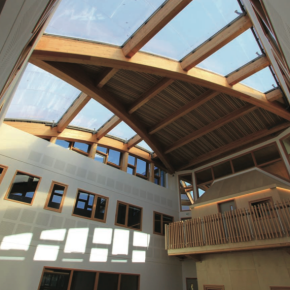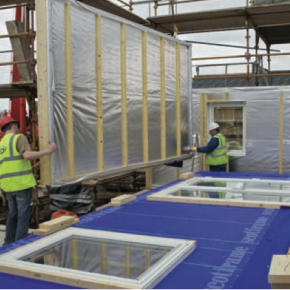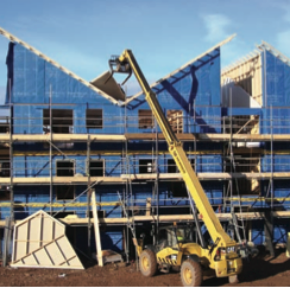
Timber trends top previous years
In November 2016, the Structural Timber Association (STA) commissioned Peter Egan of Egan Consulting to prepare a survey of UK timber markets across 2015. Andrew Carpenter, chief executive of the STA, reveals some of the report’s findings in the latest issue of ABC+D magazine.
Starting on an extremely positive note, 2016 is predicted to be another year of double digit growth, with starts estimated at circa 56,000 in timber frame.
The Timber Trends Report forecasts continued growth within the sector towards 2018 and beyond, as companies are taking advantage of market opportunities. These opportunities include factors such as advances in off-site construction supported by modern manufacturing systems and computerised technology.
Total housing starts are predicted to tip over 200,000 by 2018, with shortages in traditional skills and construction materials, encouraging the larger builders to look again at timber frame.
Structural timber technology addresses many Government concerns associated with public procurement of housing – speed of build, environmental impact, lifetime energy efficiency and cost performance – these factors are all largely beneficial, not only to Government plans but to the wider community.

“Total housing starts are predicted to tip over 200,000 by 2018, encouraging builders to look again at timber frame” – Andrew Carpenter STA.
The year 2015 proved to be successful in regards to housebuilding in the UK – showing an 8.1% increase over 2014 in housing starts. England saw an increase of 7.9%, Wales 5.1%, Scotland 4.4% and Northern Ireland saw signs of recovery since the banking crisis and the property crash – recording year on year growth of 28.6%.
At over 48,ooo starts in 2015, timber frame is approaching its pre 2008 level when 51,000 units were recorded in 2007. These results put 2015 as the second best performing year for timber frame since data began to be collected in 2002.
While the Farmer Review raises concerns about the construction industry, the structural timber sector is able to address many of these issues highlighted in this report head-on through its natural transition to becoming an increasingly factory manufactured solution, encouraging large scale use of off-site construction, which is both less labour intensive and enables quality to be more easily regulated.
Although the external influences are difficult to control, we are still able to strive to improve quality, service and productivity within our sector.
As with all sectors, Brexit holds some amount of uncertainty, however, timber is a global and innovative industry, which will grasp the opportunities and overcome any potential hurdles.
The sector has developed advantages unsurpassed by any other – the environmental credentials of wood are ones that cannot be matched by any other building material as it captures CO2 while it grows, as well as releasing relatively small amounts back into the environment after construction.
Due to advances made in off-site structural timber construction, the speed of build remains unparalleled and allows the building to remain wind and watertight.
Structural timber solutions outweigh other sectors in regards to volume of materials – the sector is quick to respond and can add capacity at a relatively rapid rate to meet demand. Shortages in other traditional construction materials will continue to encourage larger builders and specifiers to look to alternatives, such as timber frame, structural insulated panel systems or cross laminated timber.
There is plenty of confidence in the sector and, if we are to continue to thrive, the sector must continue to innovate to keep ahead of the curve. We have seen momentum grow over the last three to five years and the timber sector is well placed to continue to capitalise on the current and forecast growth.
We should be celebrating the remarkable performance achieved over the last year, in continuing to grow the UK market share for timber frame technology to 27.4%.
The market is showing higher levels of optimism amongst the structural timber solution providers, with more positive signs of investment and an increase in activity levels.
The time is right for the construction industry to embrace timber technology and off-site techniques to develop better buildings at a paid rate, to overcome the shortfall in housing stock and produce energy efficient buildings- particularly important for the social housing, education, healthcare and commercial sectors, as well as home owners and occupiers.
Latest news

19th April 2024
ASSA ABLOY: Access solutions can impact sustainability performance across the full life-cycle of a building
Embedding sustainability within any organisation requires a broad, strategic perspective. Scrutiny should include the physical infrastructure itself: According to the IEA, buildings consume around 30% of global energy*. ASSA ABLOY has more…
Posted in Access Control & Door Entry Systems, Architectural Ironmongery, Articles, Building Industry News, Building Products & Structures, Building Regulations & Accreditations, Building Services, Case Studies, Doors, Facility Management & Building Services, Information Technology, Research & Materials Testing, Retrofit & Renovation, Security and Fire Protection, Sustainability & Energy Efficiency, Video of the Week
19th April 2024
British weather doesn't dampen spirit for new HMG Garden Paint
Despite one of the wettest starts to the year on record, customers are starting to plan for brighter days with HydroPro Garden Paint from HMG Paints.
Posted in Articles, Building Industry News, Building Products & Structures, Garden, Innovations & New Products, Paints, Paints, Coatings & Finishes, Restoration & Refurbishment, Retrofit & Renovation, Site Preparation, Sustainability & Energy Efficiency, Waste Management & Recycling
18th April 2024
Abloy UK showcases new digital portfolio at The Security Event 2024
Abloy UK is set to unveil its latest line-up of access control systems at The Security Event 2024, welcoming guests to explore its cutting-edge electromechanical and digital solutions on stand 5/F50.
Posted in Access Control & Door Entry Systems, Architectural Ironmongery, Articles, Building Industry Events, Building Industry News, Building Products & Structures, Building Services, Doors, Exhibitions and Conferences, Facility Management & Building Services, Health & Safety, Information Technology, Retrofit & Renovation, Security and Fire Protection
18th April 2024
Strand is a Failsafe Choice for Emergency Exit and Panic Hardware
In times of emergency, you’re in safe hands with Strand Hardware. Although there are many considerations for building specification, few decisions can be as critical as selecting the right emergency exit/panic hardware.
Posted in Access Control & Door Entry Systems, Architectural Ironmongery, Articles, Building Industry News, Building Products & Structures, Building Services, Doors, Facility Management & Building Services, Health & Safety, Restoration & Refurbishment, Retrofit & Renovation, Security and Fire Protection
 Sign up:
Sign up: 